As a genus with more than 30 species, Myoporum parvifolium, also called creeping boobialla and creeping myoporum, is native to Australia. Around sixteen of its kinds are readily found and grown in Australia, with the low shrubs and large foliage characterising the plant and making it a great garden favourite.
This guide will cover its characteristics, the optimum growing conditions needed for the plant to thrive, its uses, care tips, and how to prevent and treat common issues that arise with the plant.
More...
Myoporum parvifolium Plant Features
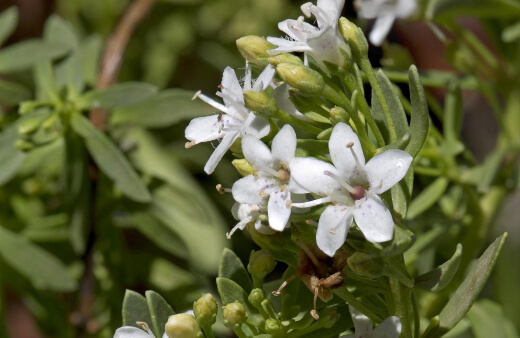
The leaves of the Myoporum parvifolium can be linear or even slightly elliptical depending on the type of plant you are growing. They have slightly serrated edges or are sometimes smooth, with flowers appearing in the centre of the leaf axils during the spring season.
With colours such as white, pink, and purple, the flowers blossom into spherical fruit. The plant is tolerant to a range of climates, given that it thrives in hotter climates with full sunlight through the years and fares well in low temperatures.
As a common groundcover plant, the Myoporum parvifolium can reach its full density in warmer climates, whereas the foliage can be sparse in wintry climates.
Given that it is such a resilient plant, it is often used as rootstock for other species of plants.
More Myoporum to Choose From
There are many other variations of the plant beside the M. Parvifolium, namely:
1. Myoporum floribundumM. floribundum takes the shape of a very slightly open shrub, at about 2.5-3 metres tall. Its tiny white flowers provide the prettiest sight for ground cover and fencing. The leaves are long and narrow, and the flowers bloom in clusters near the axils, making your ground area look like it's covered in brushings of snow. The flowers are used in ornaments, given their beautiful fragrance. | 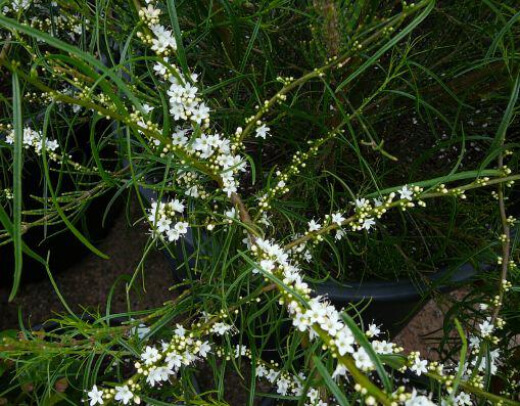 Source: redbreastplants.com.au |
2. Myoporum parvifolium Coarse Pink and Fine Leaf PinkBoth the coarse pink and the fine leaf pink are evergreens that brighten every garden space they are a part of. They are also natural weed suppressors. The white or pink flowers smell beautiful, bloom for long periods of time, and their fruit attract birds into your garden space. | 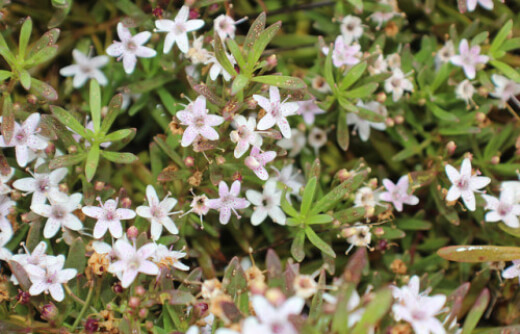 Source: onlineplants.com.au |
3. Myoporum parvifolium ‘Yareena’This variety of the Myoporum genus is tougher than its counterparts. If you live near the coast, the plant is highly salt-tolerant and can thrive in most environmental conditions, even drought and frost making it perfect for coastal gardening. The plant has slim, bright green leaves and the white flowers that are typical of the Myoporum family. | 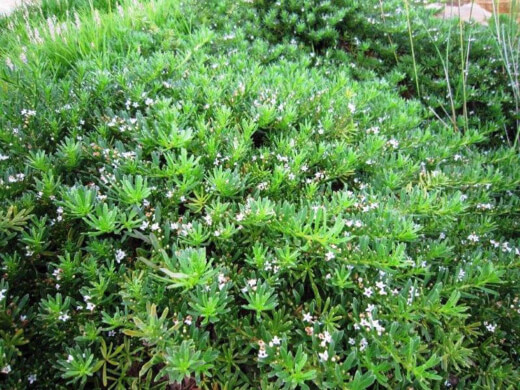 Source: plantmark.com.au |
4. Sticky Boobialla (Myoporum viscosum)This version of the myoporum earns the name “sticky boobialla” and has the same general features as the other varieties in the Myoporum family. However, the leaves and flowers are not pleasant-smelling like their counterparts, and so this plant isn’t chosen for ornamental reasons. | 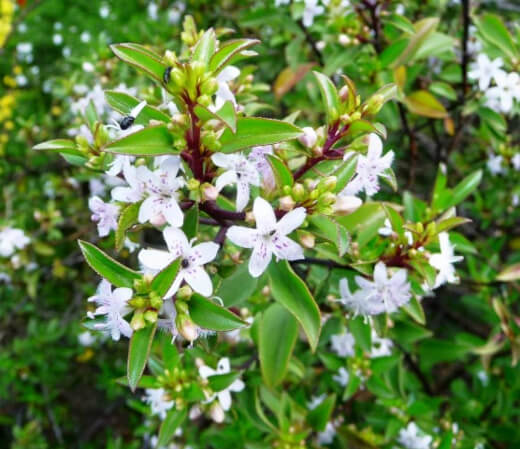 Source: resources.austplants.com.au |
This wide range of types of myoporum gives you many visuals to pick and choose for growing the plant in your garden space. These types don’t necessarily have different requirements for environmental conditions in that all are resilient and tolerant to most conditions.
1. Myoporum floribundum

Source: redbreastplants.com.au
M. floribundum takes the shape of a very slightly open shrub, at about 2.5-3 metres tall. Its tiny white flowers provide the prettiest sight for ground cover and fencing.
The leaves are long and narrow, and the flowers bloom in clusters near the axils, making your ground area look like it's covered in brushings of snow. The flowers are used in ornaments, given their beautiful fragrance.
2. Myoporum parvifolium Coarse Pink and Fine Leaf Pink

Source: onlineplants.com.au
Both the coarse pink and the fine leaf pink are evergreens that brighten every garden space they are a part of. They are also natural weed suppressors.
The white or pink flowers smell beautiful, bloom for long periods of time, and their fruit attract birds into your garden space.


Get Your Free Guide:
Master Growing Australian Natives eBook
A Must Have Complete Guide for Every Australian Garden
Get Your Free Guide:
Master Growing Australian Natives eBook
A Must Have Complete Guide for Every Australian Garden
3. Myoporum parvifolium ‘Yareena’

Source: plantmark.com.au
This variety of the Myoporum genus is tougher than its counterparts. If you live near the coast, the plant is highly salt-tolerant and can thrive in most environmental conditions, even drought and frost making it perfect for coastal gardening.
The plant has slim, bright green leaves and the white flowers that are typical of the Myoporum family.
4. Myoporum viscosum

Source: resources.austplants.com.au
This version of the myoporum earns the name “sticky boobialla” and has the same general features as the other varieties in the Myoporum family.
However, the leaves and flowers are not pleasant-smelling like their counterparts, and so this plant isn’t chosen for ornamental reasons.
This wide range of types of myoporum gives you many visuals to pick and choose for growing the plant in your garden space. These types don’t necessarily have different requirements for environmental conditions in that all are resilient and tolerant to most conditions.
Uses for Creeping Boobialla
Creeping myoporum is a spreading ground cover that creates a dense mat of leaves, making it an excellent choice for big areas where you want green coverage but don't want to mow the grass.
Because it grows so far, creeping myoporum is better planted alone rather than in a mixed bed. Because of the semi-tender leaves, it will not tolerate foot traffic.
It is a preferred ground cover in locations where water conservation is vital because of its low water requirements.
How to Grow Myoporum parvifolium
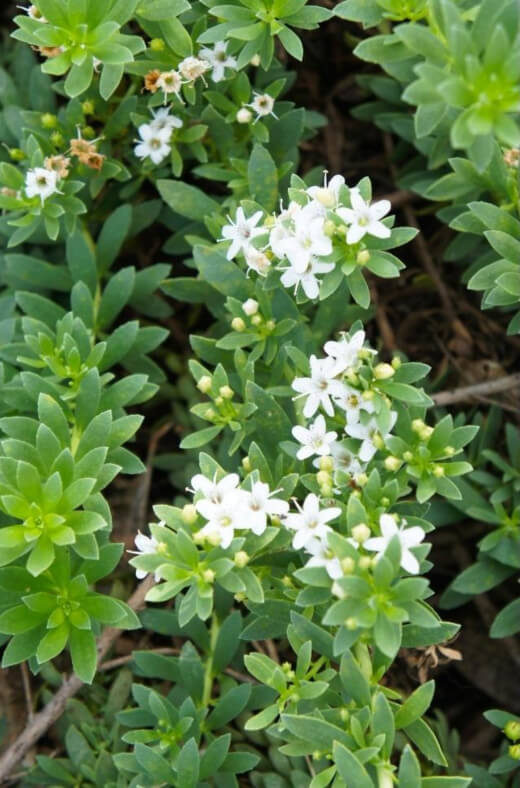
Myoporum parvifolium propagation can be sluggish in terms of germination, but seed propagation usually works without much hindrance. The best course of action to follow is to select the season’s cuttings, and use it to multiply and transplant the myoporum.
To grow creeping boobialla, you need to create conditions such as well-draining soil- the plant thrives in sandy, loamy and clay soil. Place the plantings at least 5 feet away from each other- the correct spacing enables better growth.
Select a location in the garden that receives sunlight during the day, but the plant doesn’t necessarily suffer even in half shade. Use the correct kind of fertiliser to prepare the soil.
The planting hole must be twice as big and deep as the size of the root ball you have selected to plant. Separate the root balls, and remove them from the plant carefully.
Use a garden knife if necessary to avoid ripping the root ball. Next, place the plant in the hole and fill it with soil, using your hands to press down gently.
Create a fountain-like ring of dirt or soil around the plant base for initial water retention. You can water the plant liberally in the weeks after planting, and then water it as frequently as needed.
Caring for Myoporum parvifolium

All kinds of sun levels are sufficient to keep the creeping boobialla happy and thriving. This makes the plant a good choice for both indoor and outdoor spaces.
Watering Myoporum parvifolium
The plant is also not particular about water requirements, except in the initial growing phase. After that, watering once every two weeks to keep the soil moist is sufficient watering.
If this is the watering schedule you are following, make sure you are deep watering the plant correctly. Even though the plant may look physically different and faded in winter, you needn’t water it any more than you used to in the summer.
Fertiliser
Use organic, diluted fertiliser to strengthen the plant, especially when it is established after planting. Any slow-release, low-phosphorus fertiliser when the plant looks a bit worse for wear is enough, especially after pruning and transplanting.
Pruning Creeping boobialla
Myoporum parvifolium can be beautified by some regular pruning, since the plant grows quite fast. For the shrub versions of myoporum, you need to keep the creeping tendrils at bay so they don’t overrun your entire garden.
The best time to prune is during or prior to the growing season. Use only sterilised hedge or gardening shears to prune off parts of the foliage that have yellowed or dulled. (Our review on the best hedge shears will help you with this part.)
Sterilised gardening instruments prevent cross-contamination between the different plants in your gardens. Some shrub variants of myoporum, or even in the ground cover, the plant may have bare spots as it grows older. You can plant the cuttings in said bare spots for a fuller, greener look.

Plant Spacing
Since the plant can quite literally overrun your garden if not spaced correctly or pruned appropriately, you should keep these two jobs on your roster at all times.
With a spread of up to 9 feet possible within a few short months, you should ideally plant creeping myoporum at least at a distance of 5-6 feet and trim the plant as it grows and spreads.
If you are using the creeping myoporum to serve as ground cover for your garden, the thick foliage of green leaves and white flowers can be very much a beautifying factor if spaced correctly.
Another mechanism to ensure appropriate spacing is to grow the plant on slopes and angled beds. You should keep the plant away from wherever people walk since the stems, especially when mature, are quite sharp.
Common Creeping Myoporum Pests, Diseases, and Treatment
Myoporum parvifolium is deer-resistant but particularly susceptible to fungal infections like pythium root rot, which causes a number of issues like branch diebacks, vigour loss, and even death if not treated promptly.
Root rot is nearly always a consequence of over-watering or water-logging, so the first step in prevention is well-drained soil.
Since there is no cure to a soil-borne infection like pythium, caring for the plant via infrequent watering, air circulation, and heating the soil before planting young Myoporum parvifolium are all good safety mechanisms.
Myoporum parvifolium isn’t particularly susceptible to pests, but some kinds of infestations can do irreversible damage to the plant. Myoporum thrips (Klambothrips myopori) are the pests that cause the largest degree of harm to all types of Myoporum, whether young or well-established.
The primary indicators that thrips have invaded your plant are curled leaves, leaves falling off, with the later stages of the pest infestation causing branch dieback and stem tip.
There is an easy prevention method to keeping not just thrips but all other pesky, unwanted insects away from your plants- the application of neem oil, a natural pest repellent.
Or, you can purchase a less harsh but effective pesticide and spray that liberally onto the foliage. Pests thrive in waterlogged soils, so maintain well-drained soils, and they’ll be kept at bay.
Myoporum parvifolium Frequently Asked Questions
Is Myoporum parvifolium native to Australia?
Myoporum parvifolium is native to Australia. This tough ground cover plant, with a delicate appearance, is a great way to attract native wildlife, insects, and pollinators into the garden through spring, summer, autumn, and winter, and thrives on most free-draining Australian soils.
Can you propagate Myoporum parvifolium?
Propagating Myoporum parvifolium is incredibly straight forward. If you have an existing plant, just dig out a section and plant it elsewhere. If not, sow seeds directly where they are to grow ni9 spring or early summer.
You can also take cuttings from new or old growth in spring.
Can you walk on Myoporum parvifolium?
Myoporum parvifolium can be walked on without doing too much damage, but it should not be used as a full lawn replacement if you intend to play on, or walk over the lawn on a daily basis, and the plant will need time to recover.
To use a ground cover on paths, plant it between stepping stones.
Is Myoporum parvifolium a good ground cover?
Myoporum parvifolium provides excellent ground cover, which spreads quickly but is easy to control. With an overall height of 5-10 cm, and a limitless spread, it’s ideal for planting into paths, or as edging to lawns, helping to hide messy borders, and reducing your workload with the whipper snipper.
Is Myoporum parvifolium invasive?
Myoporum parvifolium adapts well to most warm climates, so can be invasive, but is easy to control in the garden. As an Australian native, it’s not really right to think of any native plant as invasive as it’s naturally supposed to be here. If it spreads, control it.
If it takes over, consider letting it, and working out other planting to go with it for a more natural native planting scheme.
Does Myoporum parvifolium attract bees?
Myoporum parvifolium attracts native bees from summer through to winter. In spring, when flowering finishes, its berries are great for native birds too. In cooler parts of the country, the pollination season may be cut short by wet autumns, but maintaining good draining will help to mitigate that.
How tall can Myoporum parvifolium grow?
Myoporum parvifolium can grow up to 25 cm tall, but in most situations in full sun it will stay at around 10 cm tall. Like most plants, they will grow taller in search of more light if they need to, and remain compact if they have adequate light.
How does Myoporum parvifolium spread?
Myoporum parvifolium spreads by stem cuttings, seed, and layering (naturally and in cultivation). To mimic nature, simply peg trailing stems to the soil, where they will root and grow new plants, extending the spread of Myoporum parvifolium more quickly than with new plants.
How do you mulch Myoporum parvifolium?
Myoporum parvifolium does not like any excess moisture, and needs free-draining soil in all conditions, so any organic mulch is a bad idea. To aid drainage, and help to keep the foliage clean, and soil free during the rainy season, apply a 2 cm thick layer of pea gravel or grit, or even crushed brick all around the base of the plant.
Are Myoporum parvifolium berries edible?
Myoporum parvifolium berries are actually edible, but have very few common uses in the kitchen. Their berries need cooking to bring out their flavour, and remove the slightly weird seed texture, but more importantly, cooking helps to remove the strange musty scent that often overrides the sweet, slightly rosy flavour.
When should I prune Myoporum parvifolium?
The best time to prune Myoporum parvifolium is late winter, or early spring, after flowering but before berries form, every two or three years. Allowing berries to form every other year is good for the health of the plant, and will help it to spread more naturally, but an occasional winter prune can help keep its shape and size in check.
Why is my Myoporum parvifolium yellow?
Yellow leaves on Myoporum parvifolium can be a sign of stress, and are most commonly caused by overwatering or poor drainage. If you notice blackened stems or spots across the leaves, there may be a fungal problem that’s worth treating with organic fungicides.
Otherwise, just ease off on watering, and poke drainage holes through the soil around your plant as deep as possible.

Start Growing Myoporum parvifolium
Myoporum parvifolium is one plant in the family of many vibrant, aesthetically-pleasing Myoporum. (Get to know other Myoporum here). With tolerance towards varying degrees of sun, infrequent but thorough watering, and well-drained soil, Myoporum parvifolium can brighten up the face of bare spaces in your garden.
Published on January 13, 2023 by Nathan Schwartz
Last Updated on January 27, 2025




